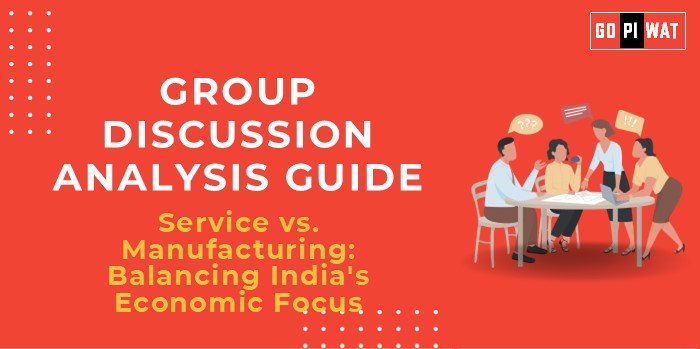📋 Service vs. Manufacturing: Balancing India’s Economic Focus
🌐 Introduction to the Topic
Opening Context: India’s economic growth hinges on the strategic emphasis between its burgeoning service sector and the evolving manufacturing industry. This decision is pivotal for sustainable development and global competitiveness.
Topic Background: Historically, India’s service sector has been a significant GDP contributor, driven by IT and BPO services. Conversely, the manufacturing sector, despite initiatives like “Make in India,” seeks to expand its footprint to boost employment and economic resilience.
📊 Quick Facts and Key Statistics
- 📈 Service Sector Contribution: Accounts for approximately 55% of India’s GDP in FY24, reflecting its dominance in the economy.
- 🏭 Manufacturing Sector Share: Contributes about 17% to the GDP, with ambitions to increase this to 25% by 2026-27 under the “Make in India” initiative.
- 👔 Employment Distribution: The service sector employs around 31% of the workforce, while manufacturing accounts for about 12%, indicating a significant employment potential in manufacturing.
- 🌍 Global Export Ranking: India ranks 9th in service exports and 18th in manufacturing exports, highlighting a disparity in global trade presence.
- 🚀 Employment Potential: Scaling the manufacturing sector could create approximately 100 million jobs by 2030, addressing unemployment challenges.
🔗 Stakeholders and Their Roles
- 🏛️ Government: Formulates policies like “Make in India” and provides incentives to boost both sectors.
- 🏢 Private Sector: Invests in infrastructure, technology, and innovation across industries.
- 🌍 International Organizations: Influence through trade agreements and global market dynamics.
- 👥 Citizens: Contribute as the workforce and consumers, impacting demand and supply.
✅ Achievements and 🚩 Challenges
✅ Achievements:
- 💻 Service Sector: India’s IT and BPO services have positioned the country as a global leader, contributing significantly to foreign exchange earnings.
- 🏗️ Manufacturing Initiatives: The Production-Linked Incentive (PLI) scheme has attracted substantial investments, aiming to boost domestic manufacturing capabilities.
- 🎓 Skill Development: Programs focusing on digital skills have enhanced the employability of the youth, aligning with industry needs.
🚩 Challenges:
- 📉 Service Sector: Faces challenges in penetrating rural markets and dealing with increasing global competition.
- ⚙️ Manufacturing: India’s manufacturing sector faces high logistics costs, estimated between 7.8% and 8.9% of GDP, compared to the global average of 8%, affecting competitiveness.
🌏 Global Comparisons and 📚 Case Studies
Global Comparisons:
- 🌉 China: Achieved manufacturing dominance through streamlined policies and large-scale production, serving as a benchmark for India.
Case Studies:
- 🏭 Tamil Nadu: Emerged as a manufacturing hub, particularly in the automotive and electronics sectors, demonstrating the potential of regional industrialization.
💬 Structured Arguments for Discussion
- Supporting Stance (Service): “India’s expertise in IT services generates higher value and global recognition, making it a strategic focus area.”
- Opposing Stance (Manufacturing): “Manufacturing offers scalable employment opportunities essential for absorbing the semi-skilled workforce, crucial for economic stability.”
- Balanced Perspective: “A synergistic approach that leverages the strengths of both sectors can drive comprehensive and inclusive economic growth.”
💡 Effective Discussion Approaches
- 🧑💻 Opening Approaches:
- “With the service sector contributing 55% to GDP, should India pivot towards manufacturing to balance economic development?”
- “Despite leading in IT services, India imports a significant portion of its electronics. Is this reliance sustainable?”
- 🔄 Counter-Argument Handling:
- “Advancements in manufacturing can stimulate service industries like logistics and IT solutions, showing their interdependence.”
📌 Strategic Analysis of Strengths and Weaknesses
🌟 Strengths:
- 💻 Established IT Industry: A leading player in global IT services.
- 👨👩👧👦 Youthful Workforce: A dynamic and growing pool of talent.
- 📈 Growing Domestic Market: Rising consumer demand across sectors.
❌ Weaknesses:
- 🚧 Infrastructure Deficits: Need for better logistics and facilities.
- ⚖️ Regulatory Hurdles: Complex compliance requirements.
- 💸 High Production Costs: A challenge for competitiveness in manufacturing.
🚀 Opportunities:
- 🤖 Industry 4.0: Adoption of AI and automation to enhance efficiency.
- 🌐 Global Supply Chains: Opportunities for integration and export growth.
- 🏭 Export-Oriented Hubs: Development of specialized manufacturing zones.
⚠️ Threats:
- 🤖 Automation: Risk of reducing employment opportunities.
- 🌍 Economic Uncertainties: Global fluctuations impacting demand.
- 🏁 Competition: Other emerging economies challenging India’s position.
📚 Connecting with B-School Applications
- 🛠️ Real-World Applications: Potential projects include analyzing supply chain efficiencies, exploring digital transformation in manufacturing, and assessing market expansion strategies for service industries.
- 🎓 Sample Interview Questions:
- “How can India balance its focus between the service and manufacturing sectors to achieve sustainable growth?”
- “Evaluate the impact of the PLI scheme on India’s manufacturing landscape.”
- 🔍 Insights for B-School Students:
- Understanding sectoral synergies can inform strategic decision-making in business operations.
- Analyzing global best practices provides insights into enhancing competitiveness in both sectors.


